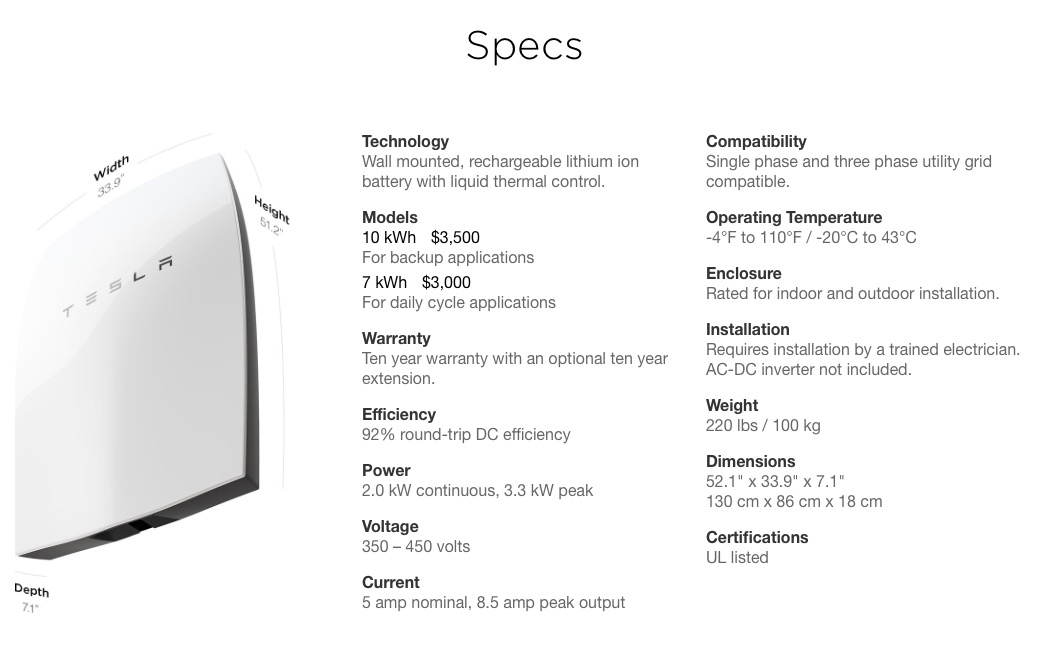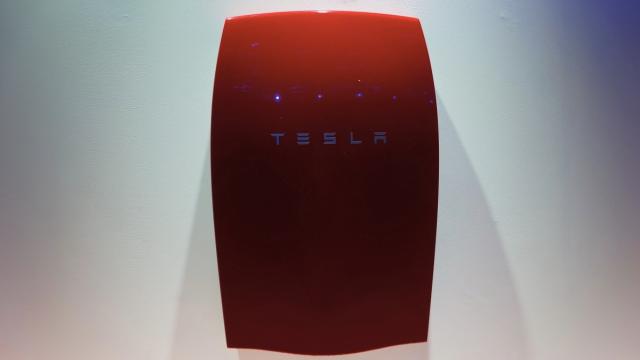I think about big, cheap batteries for a living, so I stayed up late and listened to the Tesla announcement. My first thoughts: These are fantastic prices for an uninterruptible power supply — but they’re still expensive as day-to-day electricity.
In terms of what you get compared to market prices, this is a good deal. $US350/kWhr for a 10 year battery. It doesn’t include an inverter, but it’s everything else required: cells, pack out and power electronics. In 2015, this is a lot of battery for the money. Slam dunk as an uninterruptible power supply. All numbers below assume an electrician owes you a favour — and an inverter.

Specs from Tesla’s Powerwall product page. This is the battery designed for home use.
Digging into the detail highlights the challenges that the system will face against fossil fuels. This isn’t Tesla doing anything wrong, this is the challenge of the current state-of-the-art technology. Weekly cycles at a specced discharge rate of a five-hour basis (2kW for five hours). Ten years of weekly cycles is a real number — just over 500 cycles at an 80 per cent DoD. The problem is the cost structure hurts here; if the battery is used to its specced amount, it works to $US0.66/kWhr-cycle, or over five times the market rate for electricity in New Jersey, and this doesn’t account for the generation that has to go into the battery. Even with heavily subsidised solar, that’s a combined $US0.70/kWhr-cycle. Using the battery less makes it cost more based on its intended metrics; it’s just an unfortunate coupling of batteries.
So this is the best case scenario near maximum utilisation. If you use the battery less over 10 years, you pay more per cycle (analogous to buying more land or insurance than you need). If you buy the battery, that’s a sunk cost as well. So, with the time value of money, it’s more like (very roughly) $US0.70 to $US0.75/kwhr-cycle. There is an extended warranty with pricing details on that whicare unclear, but my guess is that it would be hard for Tesla to make any money if the number dropped to below $US0.50/kwHr-cycle. I’m making things up now, so I’ll stop beating this point.
On a per-kW basis installed, it’s roughly 10 times the cost of a standard generator system, not accounting for the price of gas. Assuming gas is approximately $US0.03 to $US0.05/kWhr and the generator setup is 20 per cent efficient, the cost of energy is four times to eight times, depending on hours of use.
In rough numbers: At this cost, you either need 10 times the cycle life to compete with a generator setup at full utilisation. In order to compete with utility pricing of electricity, you need 10 times the cycle life at one-third the cost.
Playing armchair investor: Tesla probably did this to hedge against people not buying enough cars to saturate Gigafactory supply in the short turn. Despite my notes above about the challenges of the $US3500+ inverter, to be a part of the Tesla brand speaks to my ID if not my ego.
Overall, if Tesla can deliver on what it claims here, it’s an important line in the sand for this market, and it can only force prices down. Until now, Sony and Panasonic have been selling similar systems for three times the price, with little market uptake.
Everything above is subject to revision. Time makes this stuff more clear.
Dan Steingart is an assistant professor in Mechanical and Aerospace Engineering and the Andlinger Center for Energy and the Environment at Princeton University. His team listens to what batteries want and then helps them cope with what the world wants.
